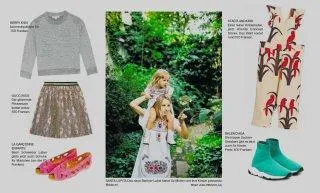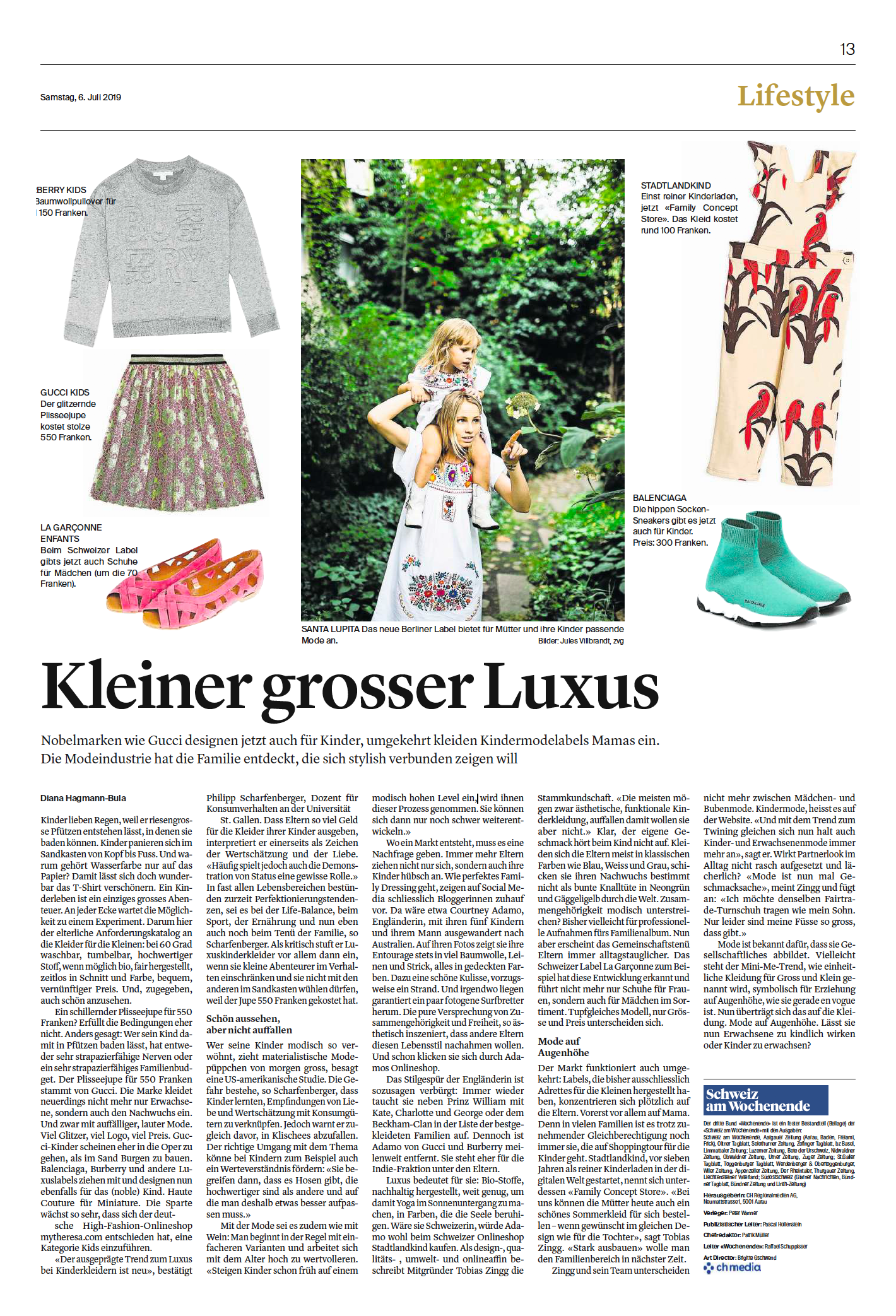
Fashion at eye level. Fair fashion for children and adults.
Upscale brands like Gucci now also design for children, while children's fashion labels dress mummies. The fashion industry has discovered the family that wants to be stylishly connected.
St.Gallen Tagblatt
Saturday 6 July 2019
Diana Hagmann-Bula
Children love rain because it creates huge puddles in which they can play. Children coat themselves in the sandbox from head to toe. And why does watercolour only belong on paper? This is a wonderful way to beautify your T-shirt. A child's life is one big adventure. At every corner there is the possibility of an experiment. That's why here's the parental catalogue of requirements for dresses for the little ones: washable at 60 degrees, can be tumble-dried, high quality fabric, if possible organic, fairly produced, timeless in cut and colour, comfortable, a reasonable price. And, admittedly, also beautiful to look at.
A dazzling pleated skirt for 550 francs? Doesn't meet the conditions. In other words: If you let your child bathe in puddles with it, you either have very strong nerves or a very strong family budget. The pleated skirt for 550 francs is from Gucci. The brand now not only dresses adults, but also their offspring. And with eye-catching, loud fashion. Lots of glitter, lots of logo, lots of price. Gucci children seem to go to the opera rather than build castles in the sand. Balenciaga, Burberry and other luxury labels are also going along and are now designing for the (high-end) child. Haute couture for miniature. The sector is growing so much that the German high-fashion online shop mytheresa.com has decided to introduce a category for kids.

"The pronounced trend towards luxury in children's clothing is new," confirms Philipp Scharfenberger, lecturer in consumer behaviour at the University of St. Gallen. He interprets the fact that parents spend so much money on their children's clothes partly as a sign of appreciation and love. "Frequently, however, the demonstration of status also plays a certain role. There are currently perfectionist tendencies in almost all areas of life,
be it in work-life balance, in sports, in nutrition and now also in the clothes of the family, says Scharfenberger. He mostly considers luxury children's clothes as problematic when they restrict the behaviour of little adventurers and are not allowed to dig in the sandbox with the others because the skirt cost 550 francs.
Look nice, but don't stand out.
According to a US-American study, those who spoil their children in such fashionable ways are raising the materialistic fashion dolls of tomorrow. According to Scharfenberger, there is a danger that Children learn to combine feelings of love and appreciation with consumer goods. At the same time, however, he warns against falling into clichés. For example, the right way to deal with the topic could also promote an understanding of values among children: "They will then understand that there are trousers that are of higher quality than others and that therefore need to be looked after more carefully.
Fashion is also like wine: you usually start with simpler variants and work your way up to more valuable ones with age. "If early on children start on a fashionably high level, this process is taken away from them. It will be difficult for them to develop further."
Where a market emerges, there must be demand. More and more parents not only dress themselves but also their children with pretty clothes. Social media bloggers are finally showing how perfect family dressing works in large numbers. There's Courtney Adamo, for instance, English, emigrated to Australia with her five children and her husband. In her photos she always shows her entourage in lots of cotton, linen and knitwear, all in subdued colours. In addition a beautiful scenery, preferably a beach. And somewhere there are usually a few photogenic surfboards lying around. The pure promise of togetherness and freedom, so aesthetically staged that other parents want to imitate this lifestyle. And they click their way through Adamo's online shop.
The Englishwoman's sense of style is, so to speak, guaranteed: Again and again she appears next to Prince William with Kate, Charlotte and George or the Beckham clan in the list of best-dressed families. Yet Adamo is miles away from Gucci and Burberry. She stands more for the indie faction among the parents.
Luxury to her is: Organic fabrics, sustainably produced, wide enough to do yoga in the sunset, in colours that soothe the soul. If she were Swiss, Adamo would probably buy from the Swiss online shop Stadtlandkind. Co-founder Tobias Zingg describes the regular customers as being design, quality, environmentally and digitally affine. "Although most people like aesthetic, functional children's clothing, they don't want to attract attention with it. Of course, the child's own taste does not stop there. If the parents usually dress in classic colours such as blue, white and grey, they certainly don't send their offspring around the world in the form of a colourful bright bag in neon green and bright yellow. Underlining togetherness with fashion until now perhaps only for professional photographs for the family album. But now the community menu for parents seems more and more suitable for everyday life. The Swiss label La Garçonne, for example, has recognized this development and now offers shoes not only for women, but also for girls. Same model, only size and price differ.
Fashion at eye level
The market also works the other way around: Labels that used to only produce clothes for the little ones suddenly concentrate on the parents. For the time being, it's mainly mummy. Because in many families, despite increasing equality, it is still her who goes on a shopping tour for the children. Stadtlandkind, launched seven years ago as a pure children's shop in the digital world, and is now called the "Family Concept Store". "Today, mothers can order a beautiful summer dress for themselves from us - if they wish, in the same design as for their daughter," says Tobias Zingg. The company plans to "strongly expand" the family segment in the near future.
Zingg and his team no longer distinguish between girls' and boys' fashion. Children's fashion, the website says. "And with the trend towards twining, children's and adults' fashions are becoming increasingly similar," he says. Doesn't a partner look quickly seem over the top and ridiculous in everyday life? "Fashion is a matter of taste," says Zingg, adding: "I want to wear the same Fairtrade sneaker as my son. Unfortunately, my feet are too big."
Fashion is known for depicting social values. Perhaps the mini-Me trend, as uniform clothing for young and old is called, reflects education at eye level, as is currently en vogue. Now this is transferred to clothing. Fashion at eye level. But does it make adults look too childish or children too grown-up?

 Thank you! You have successfully entered the newsletter!
Thank you! You have successfully entered the newsletter! 

